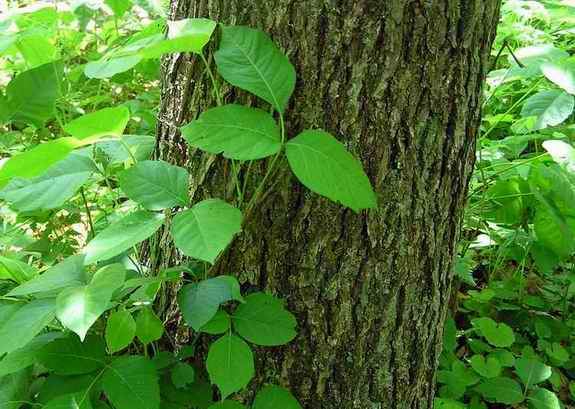|
Common Name: Poison Ivy, ""tsuta urushi" (Japan, climbing lacquer vine), "tan chi" (China, climbing vine), herbe de la puce" (Quebec, herb of the flea). Scientific Name: Toxicodendron radicans (Genus Toxidendron is from Greek toxicon, poison and dendrites, of a tree; also the genus of Poison Oak and Poison Sumac; radicans means rooting and refers to the aerial roots of Poison Ivy; formerly of Genus Rhus)
Poison Ivy is not easy to identify. Although it usually has three leaves, it can have five to seven. The leaves may have smooth edges, toothed edges or lobes and may be either shiny or matte. Poison ivy is indigenous to North America and to the Far East, where references date it to the 7th Century in China and the 10th Century in Japan. It was unknown to Europeans until the early explorations of the New World. The common name poison ivy is attributed to Captain John Smith, the leader of the colony at Jamestown. He noted that it was similar to English ivy in that it grew as a vine supported by other plants and that it produced a reaction that was malevolent in its result, like a poison. It was originally assigned the genus name Toxicodendron in 1700 by a French botanist, but Carl Linnaeus reassigned it to the genus Rhus along with poison oak, poison sumac, and about ten other non-poisonous species such as other sumacs, cashews, and mangos. About thirty years ago, botanists reestablished the original genus Toxicodendron and placed the three poisonous plants in this the "poison leaf" category. Some botanists argue that all three should be one species, as they have the same basic structure with leaves divided into a number of leaflets that are variously indented, lobed, or smooth.
The allergic reaction due to contact with poison ivy is from the urushiol oil (pronounced oo-roo-she-ol from urushi, the Japanese word for lacquer) contained in all parts of the plant except the anthers (pollen) and the wood cells (honey from poison ivy is harmless). It is so potent that only one nanogram of the oil can cause a rash; six grams or one fifth of an ounce would therefore be enough to inflict the entire global population, of which about 85 per cent is susceptible. Its potency is exacerbated by its longevity; the toxin remains viable on any surface including dead plants for up to five years. Urushiol oil penetrates into the skin and binds to cells deep in the epidermis, triggering an immune reaction. The reaction is only serious in humans, as birds eat the berries, and many animals, including deer, cattle, goats, bear, and horses eat the leaves and stems with no noticeable ill effects.
Urushiol oil is an integral part of Japanese culture as an artistic decorative lacquer coating applied to a variety of products. It has been used for at least 6,000 years, lacquer coated pots having been archaeologically recovered from a Neolithic site dated to 4500 BCE. Japanese urushi is a refined natural lacquer product derived from the sap of the Rhus verniciflua tree, a generic relative of the toxicodendrons. It is aged for up to five years and then processed to form several different products. It is applied as a thin coating over a (normally wooden) object and hardens under conditions of high humidity and high temperature to form a remarkably resilient surface that is resistant to acids, alkalis, salts and is an good electrical and thermal insulator. It has been used to coat objects such as furniture, chests, and eating utensils for centuries. American soldiers in WWII who used lacquered toilet seats during the occupation suffered accordingly. Japanese lacquered objects were the rage of Renaissance Europe and many great manors contained them. The high gloss beauty of the wooden objects led to the development of an indigenous pine sap lacquered furniture industry in Europe that became known as "Japanning."
The reaction to poison ivy proceeds in three well known stages: a rash a day after exposure due to a dilation of blood vessels; small blisters after two days due to the lymph from the blood vessels; large blisters after four days that burst and ooze. Healing proceeds in about four weeks as lymphocytes restore the damaged tissue. When urushiol oil penetrates the epidermis, it metabolizes into quinone derivatives that form complexes with proteins in the skin. These complexes are sensed as foreign bodies, triggering an attack that is manifest as an allergic immune response. The delay in onset is due to the time that it takes for the T lymphocytes to signal the presence of the invader by sending out cytokines which trigger white blood cells to attack as macrophages.
Since urushiol is oil, it must be removed with a solvent (like alcohol) or soap. The oil bonds to epidermal cells in about 30 minutes, so it is important to wash immediately after exposure. Once it bonds, it is very difficult, if not impossible to remove. A commercial product named Ivyblock has been approved by the FDA for treatment before exposure. Numerous products (Zanfel and Tecnu are the most well known) are washes that are applied after infection, purportedly bonding to the oil so it can be rinsed off. Once the rash Rhus dermatitis is contracted the itchiness can be mitigated by a variety of commercial and herbal treatments. Calamine lotion dries the skin and speeds healing; jewelweed is the most popular herbal remedy. |
